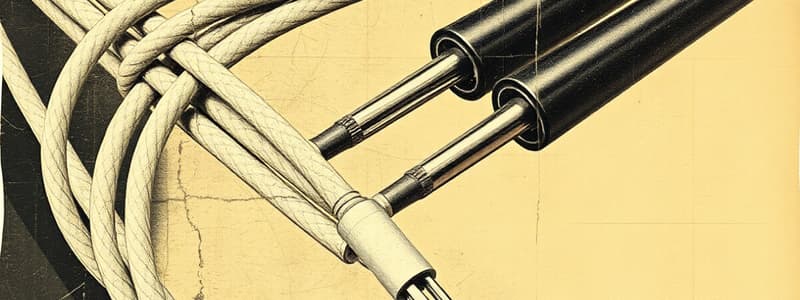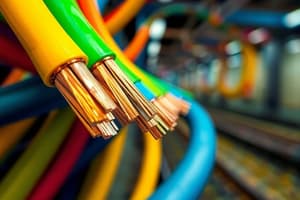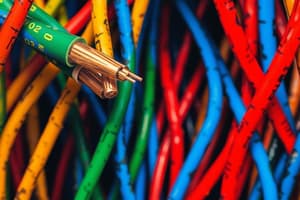Podcast
Questions and Answers
What materials are used for the construction of Double Drop wire?
What materials are used for the construction of Double Drop wire?
The Double Drop wire is made of copper conductors with diameters of 0.5mm and 0.9mm.
Describe the primary purpose of Field Service (FS) Cable.
Describe the primary purpose of Field Service (FS) Cable.
FS Cable is used to extend telephone connections for outdoor applications, especially during emergencies.
How does the PVC insulation in Double Drop wire prevent accidents?
How does the PVC insulation in Double Drop wire prevent accidents?
The PVC insulation separates L1 and L2, preventing short circuits.
What distinguishes UTP cables from STP cables in data communication?
What distinguishes UTP cables from STP cables in data communication?
Identify one key limitation of UTP cables in LAN setups.
Identify one key limitation of UTP cables in LAN setups.
What are the two types of cables used for LAN networks mentioned in the content?
What are the two types of cables used for LAN networks mentioned in the content?
List the standard lengths available for Double Drop wire coils.
List the standard lengths available for Double Drop wire coils.
What component of FS Cable provides additional mechanical strength?
What component of FS Cable provides additional mechanical strength?
What is the maximum allowed induced voltage in telecommunication circuits during the normal functioning of a power line?
What is the maximum allowed induced voltage in telecommunication circuits during the normal functioning of a power line?
During abnormal conditions in traction power lines, what is the maximum induced voltage that should not be exceeded?
During abnormal conditions in traction power lines, what is the maximum induced voltage that should not be exceeded?
What is the critical current figure recommended by the I.T.U-T to prevent electrostatic induction?
What is the critical current figure recommended by the I.T.U-T to prevent electrostatic induction?
What is the psophometric voltage limit for communication circuits to avoid interference with speech transmission?
What is the psophometric voltage limit for communication circuits to avoid interference with speech transmission?
What condition induces a maximum of 430V rms in telecommunication circuits?
What condition induces a maximum of 430V rms in telecommunication circuits?
Why should isolating transformers be introduced every 17 Km along long distance communication networks?
Why should isolating transformers be introduced every 17 Km along long distance communication networks?
How does electromagnetic interference (EMI) affect data communication over telecommunication cables?
How does electromagnetic interference (EMI) affect data communication over telecommunication cables?
What is the implications of strong electromagnetic fields on cables laid along railway tracks?
What is the implications of strong electromagnetic fields on cables laid along railway tracks?
What are the main advantages of underground (U/G) telecom cables over overhead (O/H) lines?
What are the main advantages of underground (U/G) telecom cables over overhead (O/H) lines?
Briefly explain the purpose of the colour code in polythene insulated cables.
Briefly explain the purpose of the colour code in polythene insulated cables.
What is the significance of telecommunication switchboard cables in railway applications?
What is the significance of telecommunication switchboard cables in railway applications?
Describe the impact of 25KV 50 Hz AC traction on telecommunications.
Describe the impact of 25KV 50 Hz AC traction on telecommunications.
What features distinguish double drop wire from other types of telecom cables?
What features distinguish double drop wire from other types of telecom cables?
What types of technical data are crucial for understanding telecom cables?
What types of technical data are crucial for understanding telecom cables?
What is a key feature of polythene insulated jelly filled cables?
What is a key feature of polythene insulated jelly filled cables?
How do underground PIJF cables differ from regular cables?
How do underground PIJF cables differ from regular cables?
What is the preferred method for tapping circuits according to the text?
What is the preferred method for tapping circuits according to the text?
What should be done if the trench depth is insufficient?
What should be done if the trench depth is insufficient?
On what kind of surface should cable drums be stored?
On what kind of surface should cable drums be stored?
How should cable drums be positioned during storage?
How should cable drums be positioned during storage?
What moisture prevention method should be taken for cable ends during storage?
What moisture prevention method should be taken for cable ends during storage?
What is the simplest and cheapest method of laying cables according to the content?
What is the simplest and cheapest method of laying cables according to the content?
What is a key feature of the duct system for laying cables?
What is a key feature of the duct system for laying cables?
Why is the initial cost of laying ducts considered high?
Why is the initial cost of laying ducts considered high?
What should be avoided when determining the cable route due to environmental concerns?
What should be avoided when determining the cable route due to environmental concerns?
Why is it important to avoid areas prone to water logging when laying cables?
Why is it important to avoid areas prone to water logging when laying cables?
What is the recommended separation distance from the nearest track for straight cable runs?
What is the recommended separation distance from the nearest track for straight cable runs?
What considerations should be made regarding cable routes near existing tracks?
What considerations should be made regarding cable routes near existing tracks?
How should the orientation of the cable route be determined?
How should the orientation of the cable route be determined?
What is the minimum distance to maintain between OHE masts and cables?
What is the minimum distance to maintain between OHE masts and cables?
What should be done if special lengths of cable are required for bridges or culverts?
What should be done if special lengths of cable are required for bridges or culverts?
Why is it important to verify pathways and clearances with engineering drawings?
Why is it important to verify pathways and clearances with engineering drawings?
What is the primary benefit of twisting conductors in paired telephone cables?
What is the primary benefit of twisting conductors in paired telephone cables?
How does a ground shield in paired cables function?
How does a ground shield in paired cables function?
What is a common application for telephone cables in railway systems?
What is a common application for telephone cables in railway systems?
In telecommunications, what is the significance of having no potential difference in twisted pairs?
In telecommunications, what is the significance of having no potential difference in twisted pairs?
What are the diameter options mentioned for paired cables in railway applications?
What are the diameter options mentioned for paired cables in railway applications?
How do switchboard cables differ in application from underground PIJF cables?
How do switchboard cables differ in application from underground PIJF cables?
Explain how the design of twisted pair cables contributes to noise rejection.
Explain how the design of twisted pair cables contributes to noise rejection.
What specifications are referenced for telecommunication switchboard cables and their significance?
What specifications are referenced for telecommunication switchboard cables and their significance?
What practices should be followed to ensure the protection of staff and equipment in a 25 KV 50 Hz AC traction environment?
What practices should be followed to ensure the protection of staff and equipment in a 25 KV 50 Hz AC traction environment?
What is the primary difference between PIJF underground paired cables and Quad cables?
What is the primary difference between PIJF underground paired cables and Quad cables?
Which stages are essential in the cable laying process for telecom cables?
Which stages are essential in the cable laying process for telecom cables?
What are the important types of tests required for 6 Quad PIJF cables before commissioning?
What are the important types of tests required for 6 Quad PIJF cables before commissioning?
Describe one method used for jointing underground telecom cables.
Describe one method used for jointing underground telecom cables.
What specific guidelines govern the use of Optical Fiber Cables (OFC) alongside 6 Quad cables in Indian Railways?
What specific guidelines govern the use of Optical Fiber Cables (OFC) alongside 6 Quad cables in Indian Railways?
Identify one common cause of cable failures and a precaution that may be taken to mitigate it.
Identify one common cause of cable failures and a precaution that may be taken to mitigate it.
What is a significant consideration when laying underground telecom cables near existing tracks?
What is a significant consideration when laying underground telecom cables near existing tracks?
Explain the significance of a maintenance register for 6 Quad cables.
Explain the significance of a maintenance register for 6 Quad cables.
What is the role of cable markers in underground cable laying practices?
What is the role of cable markers in underground cable laying practices?
What is the maximum longitudinally induced voltage allowed in telecommunication circuits during abnormal functioning?
What is the maximum longitudinally induced voltage allowed in telecommunication circuits during abnormal functioning?
How does electromagnetic interference (EMI) affect psophometric voltage readings in communication circuits?
How does electromagnetic interference (EMI) affect psophometric voltage readings in communication circuits?
What is the role of isolating transformers in long distance communication networks?
What is the role of isolating transformers in long distance communication networks?
What is the recommended screening factor for cables laid along the tracks to mitigate electromagnetic fields?
What is the recommended screening factor for cables laid along the tracks to mitigate electromagnetic fields?
What psophometric voltage limit must be observed in communication circuits to avoid interference with speech transmission?
What psophometric voltage limit must be observed in communication circuits to avoid interference with speech transmission?
During a short circuit condition in traction power lines, what is the maximum allowed induced voltage in telecommunication circuits?
During a short circuit condition in traction power lines, what is the maximum allowed induced voltage in telecommunication circuits?
What are the effects of strong electromagnetic fields on the communication cables laid near railway tracks?
What are the effects of strong electromagnetic fields on the communication cables laid near railway tracks?
What critical figure in milliamperes is recommended by I.T.U-T to limit electrostatic induction in communication circuits?
What critical figure in milliamperes is recommended by I.T.U-T to limit electrostatic induction in communication circuits?
What is the primary difference between CAT5 and CAT5e cables in terms of performance?
What is the primary difference between CAT5 and CAT5e cables in terms of performance?
Which category of cable can support Token Ring networks and what is its maximum speed?
Which category of cable can support Token Ring networks and what is its maximum speed?
What is the role of the physical separator in CAT6 cables?
What is the role of the physical separator in CAT6 cables?
Explain why CAT5e cables are described as 'forgiving' when deployment guidelines are not met.
Explain why CAT5e cables are described as 'forgiving' when deployment guidelines are not met.
How does the twisting of pairs in twisted copper wire cables help mitigate interference?
How does the twisting of pairs in twisted copper wire cables help mitigate interference?
What is the maximum transmission speed CAT6 supports, and over what distance?
What is the maximum transmission speed CAT6 supports, and over what distance?
What types of network traffic can CAT2, CAT3, CAT4, CAT5/5e, CAT6, and CAT7 support?
What types of network traffic can CAT2, CAT3, CAT4, CAT5/5e, CAT6, and CAT7 support?
Which category of Ethernet cable is most commonly used worldwide and why?
Which category of Ethernet cable is most commonly used worldwide and why?
What depth should pipes be laid below the formation level according to the guidelines?
What depth should pipes be laid below the formation level according to the guidelines?
How should the cable be laid when crossing over culverts or in wet areas?
How should the cable be laid when crossing over culverts or in wet areas?
What provisions should be made for laying cables on long bridges regarding temperature changes?
What provisions should be made for laying cables on long bridges regarding temperature changes?
What is the purpose of the two lengths of G.I. wire used in cable installations?
What is the purpose of the two lengths of G.I. wire used in cable installations?
What should be conducted to ensure that damaged cables are not installed during laying on bridges?
What should be conducted to ensure that damaged cables are not installed during laying on bridges?
Why is it advisable to have flagmen posted during the cable laying process on bridges?
Why is it advisable to have flagmen posted during the cable laying process on bridges?
In what circumstances must the normal dimensions of trenches be adjusted during cable laying?
In what circumstances must the normal dimensions of trenches be adjusted during cable laying?
What considerations should be taken into account for cable laying on roads with special surfaces?
What considerations should be taken into account for cable laying on roads with special surfaces?
Flashcards are hidden until you start studying
Study Notes
Telecom Cables (Copper)
- Telecom cables are used for telecommunications.
- Underground cables are advantageous over overhead lines because they are less susceptible to weather conditions, vandalism, and electromagnetic interference.
- The electrical characteristics of telecom cables depend on the type of cable, length, and frequency.
Paired Telephone Cables
- Paired cables consist of two insulated wires twisted together to reduce interference.
- The types of paired telephone cables include:
- Switchboard cables
- Field service (FS) cables
- Data communication cables
- Coaxial cables
- RF coaxial cables
- They are used for various telecommunication applications in railways, including telephone connections, data communication, and radio frequency (RF) transmission.
Underground PIJF Cables
- PIJF cables are insulated with polyethylene and filled with a jelly-like material to prevent moisture intrusion
- PIJF cables are commonly used for underground telecommunication installations in railways, especially in areas prone to moisture and dampness.
- The color code of the conductors in PIJF cables is standardized for identification purposes.
Effects of Railway Electrification on Telecom Circuits
- Railway electrification can induce unwanted currents and voltages into telecom circuits due to the electromagnetic fields generated by the traction power system.
- This interference can hinder the performance of voice and data communication by causing psophometric noise and data packet errors.
- Measures to mitigate the effects of electrification on telecom circuits include:
- Shielding the cables
- Reducing the proximity of the cables to the electrified tracks
- Using isolating transformers
- Selecting suitable cable types with high screening factors.
Cable Laying Practices
- Cables should be stored on a well-drained surface to prevent damage and moisture absorption.
- Basic methods of laying underground cables include:
- Laying directly in the ground
- Drawing through ducts
- Laying directly in the ground is the most common method, and it involves burying the cable in a trench.
- Drawing through ducts is used in areas where direct burial is difficult or inconvenient.
Paired Telephone Cables
- Paired cables are balanced via two closely spaced conductors twisted together to minimize electrical interference
- Twisted pair cabling eliminates cross-talk by ensuring the same net induced voltage across the cables, preventing current flow
- Paired cable types: switchboard cables for indoor installation and underground PIJF cables for outdoor extension
- Paired cables are used in telecom exchanges, switchboards, telephone wiring, PDH/SDH systems, RS-232 Communication Systems and Digital Transmission networks.
- CAT1 wire (untwisted) is typically used for telephone wire. It does not support network traffic and is used for ISDN and PSTN services.
- CAT2, CAT3, CAT4, CAT5/5e, CAT6 & CAT 7 wire specifications are suited for network and telephone traffic.
- CAT2 supports speeds up to 4 Mbps.
- Higher network speeds (100 Mbps or higher) require CAT5e or higher.
- CAT5e is the most widely used cabling specification worldwide and is forgiving of deviation from termination and deployment guidelines.
- CAT6 was originally designed to support gigabit Ethernet and is similar to CAT5e, but with a physical separator between pairs to further reduce electromagnetic interference.
- CAT6 supports 1Gbps for up to 100 meters, and 10Gbps for up to 55 meters.
Effects of Railway Electrification on Telecom circuits
- Excessively strong electromagnetic fields can induce unwanted current and voltage on cables, which can interfere with voice and data applications.
- Excessive electromagnetic interference (EMI) in data communication causes increased errors, network traffic, and congestion.
- EMI in analog voice communication creates psophometric noise, which degrades transmission quality.
Cable Laying Practices
- DWC pipes should be used for road crossings and laid at a depth of at least one meter below the formation level.
- At road crossings, RCC or DWC pipes of specified diameter shall be used.
- The size of the pipe should allow for future expansion and accommodate other upcoming cables.
- For laying cables under culverts, RCC or DWC pipes should be used.
- Cables are laid over culverts using GI pipes according to RDSO/TCDO/COP/13 &14.
- Consider temperature differences and provide suitable cable loops at bridge pillars.
- Lay cables sinuously inside the GI pipe to accommodate for expansion.
- Inspect and test cable drums thoroughly before laying on bridges to prevent damaged cable installation.
- Block lines, post flagmen at bridge ends as needed, to ensure staff safety.
- In rocky terrain, normal trench dimensions may not be possible.
Studying That Suits You
Use AI to generate personalized quizzes and flashcards to suit your learning preferences.



